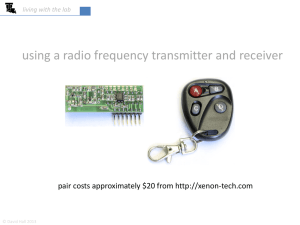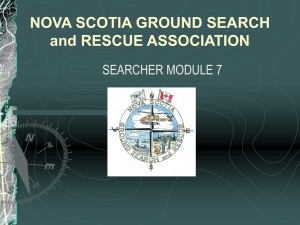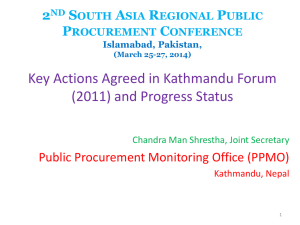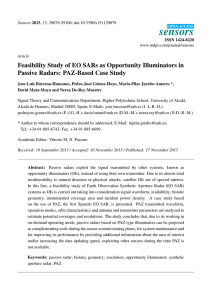1-JunjieWu_IGARSS11
advertisement
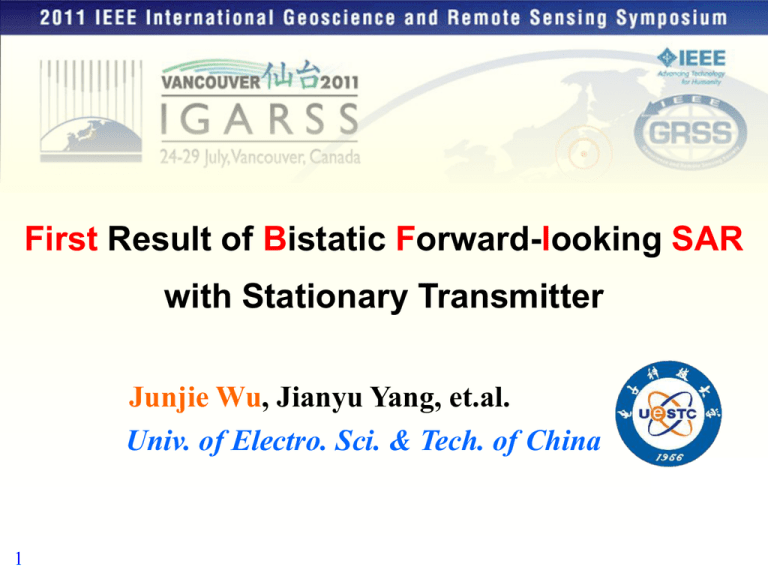
First Result of Bistatic Forward-looking SAR with Stationary Transmitter Junjie Wu, Jianyu Yang, et.al. Univ. of Electro. Sci. & Tech. of China 1 Contents 1.Introduction 2.System Setup 3.Experimental result of stationary transmitter BFSAR 4.Current work 2 May, 12th, Sichuan Mar, 11th, Tohuku 3 1.Introduction Forward-looking Squint-looking Side-looking Squint-looking 4 Backward-looking 1.Introduction Forward-looking radar imaging: • Obstruction warning • Scene matching guidance • Self-landing • Self-navigation • Materials and/or troop dropping 5 Forward looking radar Forward Squint SAR Boresight SAR Forward Squint SAR Boresight SAR 1.Introduction Why can not SAR work in forward-looking mode? 6 1.Introduction SAR imaging conditions: Iso-range and Iso-Doppler lines — • there is enough separation angle----2D resolution • sole intersection----No ambiguity Monostatic SAR imaging area: • Iso-range and IsoDoppler lines are orthogonal • Sole intersection Monostatic SAR Iso-range and Iso-Doppler lines 7 1.Introduction Monostatic SAR forward-looking area: a r • Iso-range and IsoDoppler lines are parallel • Double intersections Monostatic SAR Iso-range and Iso-Doppler lines Monostatic SAR:can not image the forward-looking area 8 1.Introduction What can we do? Separate the transmitter and receiver Bistatic 9 1.Introduction Bistatic SAR forwardlooking area: • Iso-range and IsoDoppler lines are not parallel • Sole intersections Bistatic SAR Iso-range and Iso-Doppler lines Bistatic SAR: can image the forward-looking area of the receive station 10 1.Introduction BFSAR with two moving platforms • Transmitter Side-looking or Squint • Receiver forward-looking • Spaceborne transmitter—— Airborne receiver • Airborne transmitter—— Airborne receiver • Reconnaissance • Self-navigation • Air-drop 11 Receiver Forward-looking Transmitter Side-looking BFSAR 1.Introduction FGAN-Germany • Spaceborne/airborne bistatic backward-looking experiment (2009.12) Spaceborne transmitter side-looking Resolution:1-3m Airborne receiver backward-looking 12 Area: 3×5km 1.Introduction Stationary Transmitter (ST) BFSAR Stationary transmitter • Transmitter----high tower, mountain, geostationary satellite, stratosphere low speed airship… • Receiver----airborne Forward-looking Receiver • Reconnaissance • Self-navigation • Air-drop 13 1.Introduction (a) monostatic FSAR 14 Imaging principle of ST-BFSAR (b) ST-BFSAR 2.System Setup Stationary Transmitter Vector Signal Generator Agilent 8267D target Vehicle-borne Moving Receiver Wideband signal receiver 15 2.System Setup System parameters Carrier Frequency: 9.6GHz Bandwidth: 80MHz PRF: 500Hz Pulse Width: 20us Receiver velocity: 7m/s 16 2.System Setup Downward-looking angle is too small Target Upward forward-looking 17 Downward forward-looking Equivalent 2.System Setup 18 3. Experimental results 5 1800 9 1600 8 1400 7 1200 6 1000 5 800 4 600 3 400 2 200 1 0 0 0 1000 2000 3000 4000 5000 方位向采样点 6000 7000 8000 Slow time domain 19 9000 x 10 0 1000 2000 3000 4000 5000 6000 方位向频率,采样点 7000 8000 Doppler domain 9000 3. Experimental results Imaging result of ST-BFSAR 20 4.Current Work A A O C C O B B 2D spatial variance 21 4.Current Work Keystone-based azimuth nonlinear Chirp Scaling imaging algorithm Keystone transform: Correct the linear range walk of all targets ----remove the variance of range migration NLCS: Equalize the FM rates of all targets ---- remove the variance of azimuth FM rate 22 Thank you 23


